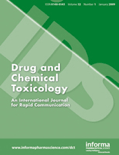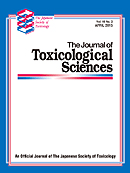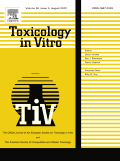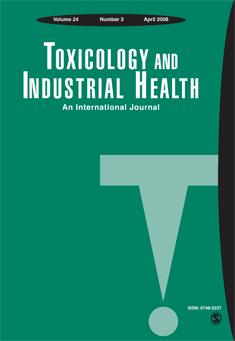
DRUG AND CHEMICAL TOXICOLOGY
Scope & Guideline
Unraveling the complexities of chemical exposure.
Introduction
Aims and Scopes
- Chemical Toxicology:
The journal emphasizes the study of toxic effects caused by various chemicals, including drugs, pesticides, and industrial chemicals, on biological systems. - Pharmacological Safety Assessment:
Research in this area focuses on evaluating the safety and efficacy of pharmaceuticals, including the investigation of side effects, toxicity, and therapeutic potential. - Environmental Toxicology:
The journal covers studies related to the impact of environmental pollutants on health and ecosystems, assessing risks and providing insights into mitigation strategies. - Natural Products and Phytochemistry:
Research involving the toxicity and protective effects of natural compounds and herbal extracts, exploring their potential benefits and risks. - Molecular Mechanisms of Toxicity:
Studies investigating the biochemical and molecular pathways through which toxic agents exert their detrimental effects on cells and organisms. - In Vitro and In Vivo Toxicity Studies:
The journal publishes research involving both in vitro (cell-based) and in vivo (animal model) studies to assess toxicological outcomes and mechanisms.
Trending and Emerging
- Nanotoxicology:
An increasing number of studies are being published on the toxicity of nanomaterials, exploring their interactions with biological systems and potential health risks. - Environmental Mixture Toxicology:
There is a growing interest in understanding the effects of chemical mixtures and their cumulative impacts on health and the environment, reflecting real-world exposure scenarios. - Biomarker Development and Toxicogenomics:
Research is trending towards the identification of biomarkers and the application of toxicogenomic approaches to elucidate the effects of toxicants at the molecular level. - Neurotoxicity Studies:
A significant increase in research focusing on neurotoxic effects, particularly concerning the impact of various chemicals on neuronal health and behavior. - Protective Effects of Natural Compounds:
Emerging studies are increasingly investigating the protective roles of natural compounds against chemical-induced toxicity, highlighting the potential of herbal remedies in toxicology.
Declining or Waning
- Traditional Chemical Toxicology:
There appears to be a decreasing emphasis on traditional toxicology studies that do not incorporate modern methodologies such as in silico modeling or advanced molecular techniques. - Single-agent Toxicity Studies:
Research focusing solely on the toxicity of individual compounds is being overshadowed by studies that explore complex mixtures and environmental interactions, reflecting a shift towards more ecologically relevant research. - Pharmaceutical Toxicity without Mechanistic Insights:
There is a noticeable decline in studies reporting pharmaceutical toxicity without delving into the underlying mechanisms, as the field increasingly values mechanistic understanding.
Similar Journals

Current Research in Toxicology
Unveiling the Complexities of Toxicological ImpactCurrent Research in Toxicology is a pioneering journal published by ELSEVIER that serves as a vital platform for disseminating cutting-edge research in the field of toxicology, spanning from biological impacts to pharmacological applications. With an ISSN of 2666-027X and an impressive Q2 ranking in key categories such as Applied Microbiology and Biotechnology, Health, Toxicology and Mutagenesis, and Toxicology, this journal underscores its commitment to high-quality research and significant contributions to the scientific community. Based in the Netherlands, Current Research in Toxicology aims to bridge the gap between academia and industry by providing rigorously peer-reviewed articles that cover a wide array of topics including novel methodologies, regulatory challenges, and emerging trends within the domain. The journal is accessible through various platforms, making it essential for researchers, professionals, and students eager to stay updated on the latest findings and advancements in toxicology. With a comprehensive focus on integrating theory with practical application, this journal is poised to influence future studies and policies in health and environmental science.

Toxicology Research
Pioneering research in toxicology and mutagenesis.Toxicology Research is a distinguished journal dedicated to advancing the field of toxicology through the dissemination of high-quality research. Published by Oxford University Press, this UK-based journal focuses on critical aspects of toxicology and mutagenesis, highlighting both environmental and pharmacological implications. With an ISSN of 2045-452X and an E-ISSN of 2045-4538, it serves as a valuable resource for researchers, professionals, and students alike. Currently categorized in the Q3 quartile for Health, Toxicology and Mutagenesis, as well as Toxicology in 2023, Toxicology Research maintains a visible presence in Scopus rankings, positioning itself within the targeted professional community. Although the journal operates without open access options, its importance in contributing to scientific discussions and policy formation is undeniable. Covering content from 2012 to 2024, it continues to provide insights into contemporary toxicological challenges, thereby fostering interdisciplinary collaborations and informing best practices in health and safety.

JOURNAL OF APPLIED TOXICOLOGY
Transforming Toxicology Through Rigorous ExaminationJOURNAL OF APPLIED TOXICOLOGY, published by Wiley, stands as a leading platform in the field of toxicology, focusing on the rigorous examination of chemical substances and their effects on biological systems. With an impressive Impact Factor, it ranks in the top quartile (Q2) for toxicology journals, reflecting its esteemed position within the scientific community. The journal, identifiable by its ISSN 0260-437X and E-ISSN 1099-1263, has been an invaluable resource since its inception in 1981, and it continues to serve as a conduit for innovative research and practical applications through 2024. Positioned at the forefront of the field, it garners recognition in the Scopus Rankings, where it ranks #31 out of 133 journals in the toxicology category, placing it in the 77th percentile—a testament to its contribution to the advancement of pharmacology and toxicological sciences. While not an open-access journal, it remains accessible to a wide audience of researchers, professionals, and students eager to explore cutting-edge findings in applied toxicology, making it a pivotal resource for enhancing knowledge and fostering collaboration in the field.

JOURNAL OF TOXICOLOGICAL SCIENCES
Fostering Collaboration in Toxicological ResearchThe Journal of Toxicological Sciences, published by the Japanese Society of Toxicological Sciences, is a prominent academic journal dedicated to the comprehensive study of toxicology and its related fields. Since its inception in 1976, the journal has provided a vital platform for researchers and professionals to disseminate innovative findings and insights in toxicology, with a focus on both experimental and clinical studies. Positioned in the Q3 quartile across various relevant categories, including Medicine (miscellaneous) and Toxicology as of 2023, the journal plays an essential role in advancing our understanding of toxic substances and their effects on biological systems. Although currently not open access, the journal maintains high academic standards and is indexed in Scopus, ranking #96 in Toxicology. Offering unique perspectives from Japan, it encourages global collaboration and discourse among toxicologists, making it an invaluable resource for students, researchers, and industry professionals alike.

TOXICOLOGY IN VITRO
Unveiling the Science of Safety in In Vitro StudiesTOXICOLOGY IN VITRO is a premier journal published by PERGAMON-ELSEVIER SCIENCE LTD, focusing on the latest advancements in the field of toxicology, particularly through in vitro methodologies. With an ISSN of 0887-2333 and an E-ISSN of 1879-3177, this journal serves as a critical platform for researchers aiming to disseminate their findings in toxicology, emphasizing innovative approaches and applications in pharmacology and toxicology. Featuring a commendable impact factor and classified in the second quartile (Q2) for both Medicine (miscellaneous) and Toxicology in 2023, the journal holds a significant position within the academic community, ranking 41st out of 133 in the Toxicology category according to Scopus, representing the 69th percentile. Despite being a subscription-based publication, it continuously attracts submissions from leading scientists worldwide, fostering a vibrant exchange of scientific knowledge. Since its inception in 1987, TOXICOLOGY IN VITRO has consistently aimed to enhance understanding of toxicological challenges, making it an invaluable resource for professionals, students, and researchers dedicated to developing safer pharmaceuticals and understanding the biological pathways influenced by potential toxic agents.

TOXICOLOGY MECHANISMS AND METHODS
Advancing toxicological insights for a safer tomorrow.TOXICOLOGY MECHANISMS AND METHODS is a distinguished peer-reviewed journal dedicated to the advancement of toxicological research, published by Taylor & Francis Ltd. With its ISSN 1537-6516 and E-ISSN 1537-6524, this esteemed journal features critical studies and innovative methodologies in the field of toxicology, aligning with its mission to enhance understanding of biological mechanisms and risk assessment. The journal holds a commendable Q2 ranking in both the Health, Toxicology and Mutagenesis, and Toxicology categories, as well as strong positions in Scopus rankings, reflecting its influence with a 71st percentile rank in Toxicology and a 69th percentile rank in Environmental Health. Researchers, professionals, and students in the toxicology domain will find this journal to be an invaluable resource, offering open access options that foster widespread dissemination of its findings. Since its inception, encompassing converged years from 1991 to 1995 and from 2002 to 2024, the journal remains at the forefront of critical discourse and innovative research methods, making it a vital platform for advancing toxicological science globally.

JOURNAL OF BIOCHEMICAL AND MOLECULAR TOXICOLOGY
Exploring the Intersection of Health and ToxicologyJournal of Biochemical and Molecular Toxicology, published by Wiley, plays a pivotal role in the advancement of knowledge within the fields of biochemistry, toxicology, and molecular biology. Established in 1998, this esteemed journal has garnered a significant reputation, evidenced by its current placement in the Q2 quartile across several categories, including Biochemistry, Health, Toxicology and Mutagenesis, and Medicine. With an ISSN of 1095-6670 and an E-ISSN of 1099-0461, it serves an international audience, offering critical insights and innovative research that shape our understanding of biochemical interactions and toxicological assessments. While it does not operate on an open-access model, the journal ensures rigorous peer review and high-quality publication standards, making it a valuable resource for researchers, professionals, and students dedicated to the exploration of molecular toxicology. The journal's recognized impact within the scientific community is reflected in its competitive rankings among specialized journals, fostering significant contributions to both academic and applied contexts.

ARCHIVES OF TOXICOLOGY
Illuminating the Path in Toxicology and HealthARCHIVES OF TOXICOLOGY is a prestigious journal published by Springer Heidelberg, dedicated to advancing research in the field of toxicology and related disciplines. With a distinguished history dating back to 1930, this journal has continuously provided vital insights and groundbreaking studies, making it a cornerstone in the areas of health, toxicology, and medicine. Recognized for its high impact, it occupies a top-ranking position in Scopus, with remarkable quartile placements in 2023, categorizing it as Q1 in Health, Toxicology and Mutagenesis, and Q1 in Medicine (Miscellaneous). The journal highlights critical research and innovative methodologies, appealing to a diverse audience of researchers, professionals, and students committed to understanding the complexities of toxic substances and their implications for public health and environmental safety. The journal does not currently offer open access, allowing for a more traditional but rigorous peer-review process that ensures the quality and integrity of every published article. Join the global discourse in toxicological science with ARCHIVES OF TOXICOLOGY, where every contribution furthers the understanding of safety and toxicity in our world.

ECOTOXICOLOGY
Unraveling the complexities of chemical interactions in nature.ECOTOXICOLOGY is a prominent journal published by Springer, focusing on the interdisciplinary field of ecotoxicology—a critical area dedicated to understanding the impact of chemicals and pollutants on ecosystems and human health. Established in 1992, the journal has steadily gained recognition and currently holds a strong position in the academic landscape, featuring a Q2 ranking across multiple categories including Health, Toxicology and Mutagenesis, and Environmental Science. With its rigorous peer-review process and commitment to high-quality research, ECOTOXICOLOGY serves as an essential platform for disseminating innovative studies, systematic reviews, and policy analyses, thereby contributing significantly to environmental management and law. Although it does not offer open access, authors benefit from the reach and reputation of Springer, ensuring their work is seen by an engaged audience of researchers, professionals, and academics. As the field of ecotoxicology continues to evolve, ECOTOXICOLOGY remains at the forefront, addressing key challenges and solutions essential for safeguarding our environment and public health.

TOXICOLOGY AND INDUSTRIAL HEALTH
Fostering a safer tomorrow through comprehensive toxicology research.TOXICOLOGY AND INDUSTRIAL HEALTH, published by SAGE PUBLICATIONS INC, is a premier journal in the field of toxicology, public health, and environmental health, with a significant history dating back to 1985. With its ISSN 0748-2337 and E-ISSN 1477-0393, the journal provides a platform for disseminating groundbreaking research and comprehensive reviews that address the complexities of toxic substances in industrial and occupational settings. Despite its Q3 ranking among peers in health, toxicology, and public health, this journal is becoming increasingly influential, reflected in its growing citation metrics. Researchers and professionals benefit from its commitment to fostering knowledge in both theoretical and practical contexts, making it an essential resource for those dedicated to advancing understanding in this vital field. The journal's main objectives include promoting research addressing the implications of toxicology on health and safety standards across industries, ensuring accessibility to current studies for a global audience. Overall, TOXICOLOGY AND INDUSTRIAL HEALTH plays a critical role in bridging the gap between research and real-world applications, proving invaluable to students, professionals, and researchers alike in their pursuit of enhancing public health and environmental safety.